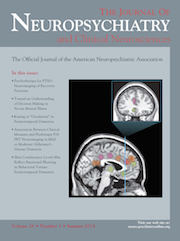Seizure With Sertraline: Is There a Risk?
To the Editor: Seizures are serious adverse effects of some antidepressant drugs, and a better understanding of drug-related seizure risk, its predictors, and possible neuroanatomical basis might help to reduce this adverse event. Among the various antidepressants, selective serotonin reuptake inhibitors (SSRIs) are believed to have a lower seizure risk.1 However, various types of seizures are reported with the use of sertraline, particularly with a higher dose, including generalized seizures,2 partial seizures,3 and myoclonic seizures.4 Also, combining sertraline with other drugs such as clozapine and methylphenidate has been reported to precipitate seizures.3,5 We report a young woman who developed both myoclonic jerks and generalized seizure with sertraline.
Case Report
“Ms. A,” a 23-year-old single woman, presented with altered consciousness following suicidal ingestion of organophosphorus compounds during a depressive episode and was treated in the intensive care unit. She had two episodes of generalized seizures during the recovery period.
A CT scan of brain was done, which was normal. Following recovery from organophosphorus poisoning, she was diagnosed to have severe depressive episode and started on tablet sertraline 25 mg/day, which was gradually increased to 150 mg/day over 4 weeks. There was significant improvement in her depressive symptoms with a reduction of 20 points in the Hamilton Depression Rating Scale. For the next 8 months, she maintained well on sertraline 150 mg without any emergent adverse effect. At follow-up, she had developed sudden jerky movements of her hands and shoulder that occurred twice or three times a day. Over the next week, the frequency increased to approximately 10 times a day, and she developed one episode of generalized tonic-clonic seizure. Investigations including complete blood counts, renal and hepatic profile, blood sugar, and serum electrolytes were within normal limits. An EEG study was done, which did not reveal epileptiform activities. Considering the possibility of sertraline-induced seizures, the medication was reduced slowly to 25 mg/day in next 3 weeks. Soon the myoclonic jerks were reduced to one to two per day. Later, sertraline was tapered and stopped; since then, the patient did not experience any myoclonic jerks or generalized seizure in the next 3 months. There has been no relapse of her depressive symptoms.
Discussion
Seizures with sertraline have been reported in young patients with prolonged duration of treatment4 and a high dose or overdose of medication.2,6 Seizures are also observed in patients developing serotonergic syndrome or the syndrome of inappropriate antidiuretic hormone secretion (SIADH) associated with sertraline.7 Although the risk of seizure is generally considered to be low with SSRIs, these factors increase the risk of seizures. Also, increased serotonergic transmission lowers the seizure threshold leading to myoclonus or seizures through coactivation of 5-HT1A and 5-HT2 receptors in brainstem.8 Prolonged use of SSRIs upregulates these receptors in the brainstem and inferior olive, and sets the olivocerebellar rhythmicity that causes myoclonus.9 In patients with pre-existing seizures, sertraline causes a definite increase in seizure frequency.10 Our patient also developed myoclonic seizures and one episode of generalized seizure with a higher dose of sertraline that improved with discontinuation of the medication. Also, our patient had two episodes of generalized seizures during organophosphorus poisoning, which might increase the risk of seizures with sertraline. The above data show that sertraline has a definite risk of seizures in vulnerable patients and needs to be used cautiously. It is advisable to lower the dose to the minimum effective dosage when a patient is exposed to the drug for a prolonged period.
1 : Seizures associated with antidepressants: a review. J Clin Psychiatry 1993; 54:289–299Medline, Google Scholar
2 : Seizure associated with sertraline. Aust N Z J Psychiatry 1999; 33:944–945Crossref, Medline, Google Scholar
3 : Partial seizures with secondary generalization while on treatment with clozapine and sertraline: a case report. Prim Care Companion J Clin Psychiatry 2009; 11:127–128Crossref, Medline, Google Scholar
4 : Myoclonus during prolonged treatment with sertraline in an adolescent patient. J Child Adolesc Psychopharmacol 2001; 11:199–202Crossref, Medline, Google Scholar
5 : Seizures induced by the combination treatment of methylphenidate and sertraline. J Child Adolesc Psychopharmacol 2008; 18:301–303Crossref, Medline, Google Scholar
6 : Massive sertraline overdose. Ann Emerg Med 2000; 36:524–526Crossref, Medline, Google Scholar
7 : Seizure and transient SIADH associated with sertraline. Am J Psychiatry 1996; 153:732Crossref, Medline, Google Scholar
8 : Drug-induced myoclonus: frequency, mechanisms and management. CNS Drugs 2004; 18:93–104Crossref, Medline, Google Scholar
9 : The serotonin hypothesis of myoclonus from the perspective of neuronal rhythmicity. Adv Neurol 2002; 89:307–329Medline, Google Scholar
10 : The use of sertraline in patients with epilepsy: is it safe? Epilepsy Behav 2000; 1:100–105Crossref, Medline, Google Scholar



